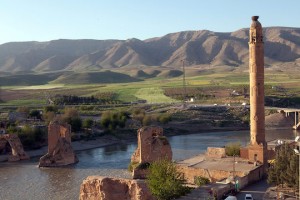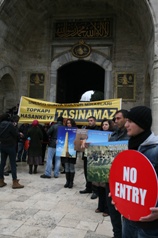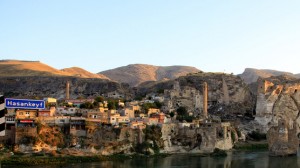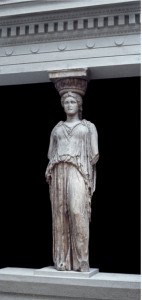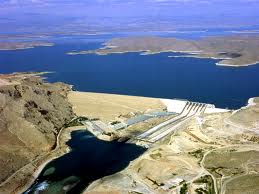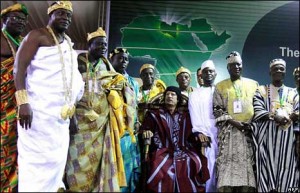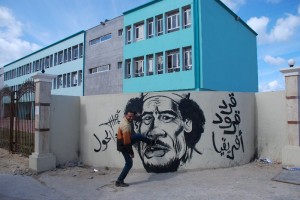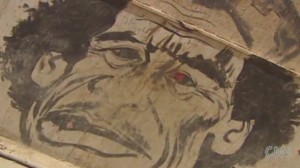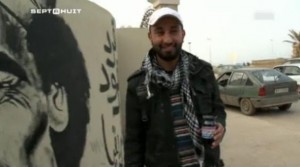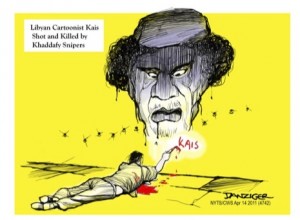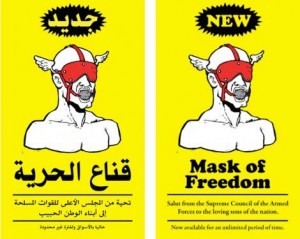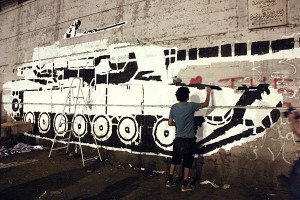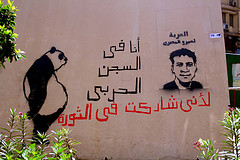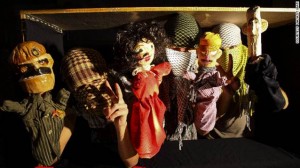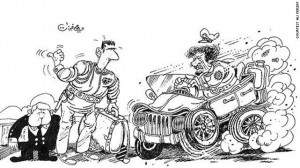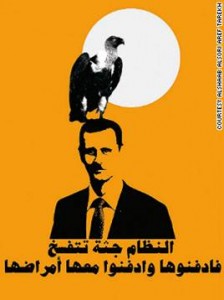Contemporary Art and Archeology in the Middle East: Crying Caryatids, Flooded Histories, Graffiti, and Puppet Shows

inside the ancient bridge at Hasankeyf
Contemporary art and even the study of archaeology in the Middle East are deeply embedded in the dramatic economic pressures and political stress in that part of the world.
To start with the most surprising topic, contemporary study of archaeology as a practice, “Indigenous Archaelogies of Ottoman Anatolia: Decolonizing Spolia” presented at the College Art Association Conference by Benjamin Anderson of Cornell University was a clearly argued lecture calling for consideration of the indigenous point of view on archaeological objects and sites, not just the interests of economic and intellectual elites.
A current example is the battle to save Hasankeyf (above) on the Tigris River, about to be flooded by a new dam along with 600 other sites on the Tigris. In 2009 there was a big effort to make it a World Heritage site, but the Turkish government refused to support it. The village has been an active settlement for 12,000 years. Below we see the villagers protesting the plans to flood it. The dam is built though and the floodgates will open any day. It is part of the GAP project, the massive Eastern Anatolian development that is meant to make Turkey energy independent ( while it destroys history, cultures, massive tourist destinations and natural habitats for rare animals.)
Spolia is the re-use of archaeological remnants in later architecture, but its roots are in the word “spoils” based in the Italian word, “spogliare” to strip. Archaeological spolia enter a second history when they are part of a new fabric; in some cases they have a spiritual or even mythic meaning to local people entirely different from the original significance of the work.
According to Ben Anderson’s recounting, it is told that people heard the caryatid maidens from the Parthenon cry as one of their sisters was removed by Lord Elgin!
In the removal of ancient sculptures from sites there is frequently (even today) collusion between elites, archaeologists and the government, and a complete disregard of the feelings of the people in a local community where the object is embedded.
The removal of pieces to European museums was rampant in the 19th century. Apparently the first law to prevent this was passed in 1869. We are all familiar with the ongoing repatriation campaign particularly for the return of the Elgin Marbles to the Acropolis Museum. Now we have another reason for them to return: the crying maidens and maybe the grieving gods of the tympana as well. But no amount of crying is going to survive the drowning about to happen at Hasankeyf.
“Submerged Stories on the Sidelines of Science” a presentation by Laurent Dissard at the University of California, Berkeley, also talked about the “others” of archaeology, in this case people living at the site of what became the Keban Dam on the Euphrates River, built between the 1964 and 1977 in Eastern Anatolia. As teams of archaeologists came to rescue sites about to be submerged, they paid scant attention to the local people who lived and worked the land in the villages near the dam (162 villages and 50 hamlets were flooded). These people did not own their land so they received no compensation. They lost everything, but they are barely mentioned in reports and barely visible in the photographs. These are the “marginalized others” such as Kurds, Armenians, and Alevis that Dissard attempts to bring back to life from their erasure.
And of course his thesis relates directly to the situation at Hasenkeyf where dozens of marginalized histories are being destroyed in order to deliver power to the center (both literally and metaphorically)
“A Revolution in Art? The Arab Uprisings and Artistic Production” presented by the Association for Modern and Contemporary Art of the Arab World, Iran and Turkey (AMCA) at the College Art Association was also full of dramatic revelations, particularly about revolution graffiti in Libya and Egypt.
In her talk “’King of Kings of Africa’: Racializing Gaddafi in the Visual Output of the 2011 Libyan Revolution” Professor Christiane Gruber of the University of Michigan, a specialist in Islamic culture,
spoke of a particular type of street graffiti. the street imagery specifically in Benghazi, where African mercenaries (Tuareg from Mali who have been revolutionaries for decades in their own country) killed many Benghazis as part of Gaddafi’s mercenary forces.
Gaddafi was a big financial supporter of various countries in Africa and was elected President of the African Union of 53 states in 2009. He had been proposing a United States of Africa as a way to stability (one wonders if this is why we were so eager to do him in). In 2008, 200 African Kings endowed him with the title of “King of Kings” of Africa in Benghazi. He declared “We want an African military to defend Africa, we want a single African currency, we want one African passport to travel within Africa.” Kings all dressed in traditional royal clothing and gold crowns came from all over the continent, including Mozambique, South Africa, Ivory Coast and the Democratic Republic of Congo.
During the Revolution, Benghazi cartoonists, particularly the artist Qays al-Hilali, poured out their anger at the oppressive society in Libya. Qays transformed Gaddafi from the King of Kings to the “Monkey of all Monkeys.” (I did not find those images available online)
The monkey in local culture, according to Gruber, is a sycophant, hypocrite and trickster, as well as representing cunning. She pointed out that the language of the cartoons’ epithets was a street Arabic specific to Benghazi.
The caricatures emphasize his afro hair and “ape-like” feature. Qays al Hilali was killed during the uprising, intentionally it would seem, because of his explicit cartoons.
Although there has been a flowering of murals in many places in Libya, only in Benghazi is are the references so explicitly targetting Gaddafi as “King of Kings.”
Professor Gruber concluded her presentation by providing analytic tools for thinking about what she called “conflict aesthetics”. The concepts she listed were incongruity, metaphor, stereotypes, and turning the morally objectionable into a joke. These works she said violated predictable conceptual patterns. These are definately concepts to think over. Very few people ( including myself) take a step back from street art to try to analyze it aesthetically.
Jennifer Pruitt speaking on “Painted Discontent: The Role of Street Art in the Egyptian Revolution” discussed the changing dynamic of street art over the course of the uprising in 2011 as murals were created, altered, painted, over, effectively switching sides day by day. Martyr paintings were vandalized by pro Mubarek forces, then repainted.
Ganzeer is by far the best known of those artists. He has even been featured in Art in America as part of “The New Realism.” He painted 18 martyr portraits, some of them viewable online with a map to locate them at cairostreetart.com
He plastered this ironic and frightening image around Cairo at the height of the uprising.
Ganzeer here is painting one of his most famous murals. Below is the full mural, the encounter of the tank and the bicycle with the person carrying bread. It was later painted with streams of blood under the wheels, as well as being painted out. But much graffiti survives online. This virtual catalog is invaluable as a record of the specific images and sometimes their changing conditions.
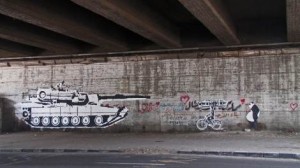
The tank and the bicycle. Note the sad panda ( the artist called himself Sad Panda) on the far right by a different artist. This mural went through many repaintings,echoing the power struggle in the streets
Last night, at the University of Washington, I heard a third talk on culture in the midst of uprising: “Ideology and Humor in Dark Times Notes from Syria, Memos to the President,” by Professor Lisa Wedeen sponsored by the Jackson School at the University of Washington. Her main theme was that a neoliberal autocracy and consumer culture had created an affluent culture in Damascus and Aleppo that had little interest in the uprising initially. Neoliberalism created sites and images that constructed and served a wealthy society of privilege. And, the people killing the revolutionaries, the “regime thugs” were frequently hired by Assad from low income areas. The privileged said, according to Professor Wedeen, “It will resolve itself.”
As the situation worsened, the youth of the privileged joined the uprisings, and of course, today, nobody can ignore it any longer. The battle has been taken directly to Aleppo and Damascus. We heard about certain popular culture soap operas like “A Forgotten Village” actually supported by the regime even as it was making jokes about the surveillance society. These consumer oriented products of entertainment were examples of pressure valves organized by the regime. So they stood in a complicit relationship to the Assad government.
Such a situation of co-opting a critical voice has a long tradition in Syria as pointed out by miriam cooke (She writes her name in a lower case) in Dissident Syria, making oppositional arts official, Cooke discusses performance art, visual art, films, and “prison literature” as a negotiation between the State’s controls (this is under Assad’s father Hafiz), and their desire to be in opposition to its policies, while not ending up in jail. Even more complicated to think about is the idea that “the state that controlled and sometimes silenced them also needed them.” (4)
In the last two years, there are also contemporary dissident voices in Syria who are not at all part of the consumer or official culture. The puppet show “Top Goon Diaries of a Little Dictator” by the collective Massasit Matti has produced two Seasons and 17 episodes of comedic critique of the government. I would love to read an analysis of it in the context of the history of puppetry in the Middle East. Season 2, No 17 and the last episode, is chillingly pertinent, it ends with the Assad puppet placed in a coffin and the cover closed on him. This puppet show is easily viewable on You Tube. It was partially funded by money from abroad giving it a very different relationship to the regime that commercial soap operas.
Ali Ferzhat is a famous cartoonist who was formerly supported by the regime, but now criticizes it. He was attacked by the regime, some of his fingers were cut off. He now works from outside the country. There are others as well like the poster collective that made this poster.
Culture is always embedded in politics. It can be sacred objects shipped abroad from archaeology sites by colonial elites or villages drowned under water by economic development; it can be street graffiti finally free to lampoon a hated leader in Libya or militarism in Egypt, it can be carefully crafted online videos that document protests in New York or DC, it can be theater that protests injustice in historical contexts that are still resonant, it can be writers and poets who say one thing and mean another (I remember meeting a filmmaker from Croatia who spoke of how everyone could read between the lines under socialism), it can be producers of soap operas in Syria who are protesting the government oppression with the government’s support.
It can be a blog that tries to explore all the possible ways of thinking about art and politics.
This entry was posted on February 23, 2013 and is filed under Art and Activism, Art in War, Contemporary Art.

